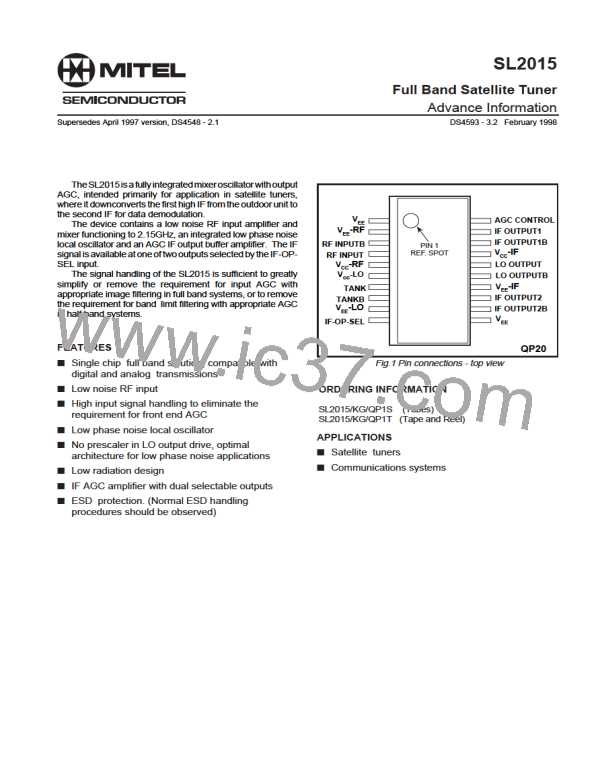SL2015
e) ThedifferenceinlevelindBbetweenthefundamentalsand
the 3rd order products is the IM3 of the device.
Measurement of IM3 and IP3
f) IP3 may be calculated from the above reading as follows:
IP3 = RF input level + IM3/2.
a) Input two signal tones from RF generators. The level of
these should be adjusted so that the device sees an input
signal level of -19dBm from each tone.
This level is usually referred to the input.
e.g.
Programthelocaloscillatorsothatbothtonesaremixeddown
to the IF (approx).
b) Adjust the AGC so that the device gives an overall
conversion gain of +5dB.
Assuming a measured IM3 of 44dB, and with an input level of
-19dBm,
IP3 = 44/2 + -19dBm = +3dBm
c) Connect a spectrum analyser to the selected IF output of
the device.
Ina50Ω system,thismaybeconvertedtodBuVbyadding107
to the value calculated since 0dBm = 107dBµV.
d) Measure the relative levels of the down converter signals
and the 3rd order products (see diag overleaf).
Two input signals are used:
i.e. +3dBm = 110dBuV.
f1 = 950MHz
f2 = 951MHz
This is known as the input referred IP3 of the device.
The local oscillator flo is tuned to 1430MHz.
This gives the following at the IF output:
fa = 1430MHz - 950MHz = 480MHz
fb = 1430MHz - 951MHz = 479MHz
If you experience any difficulties with this board, or require
further help, please contact Robert Marsh on 01793 518234
or Fred Herman on 01793 518423. The fax number is 01793
518411.
Mixing products are also produced in the front end. These
are then downconverted by the mixer.
The in-band ones are listed below:
fd = flo - (2 x f1 - f2)
fc = flo - (2 x f2 - f1)
fd = 1430MHz - (2 x 950MHz - 951MHz) = 481MHz
fc = 1430MHz - (2 x 951MHz - 950MHz) = 478MHz
fundamentals
3rd order product
3rd order product
fa
fb
fd
fc
10

 MITEL [ MITEL NETWORKS CORPORATION ]
MITEL [ MITEL NETWORKS CORPORATION ]